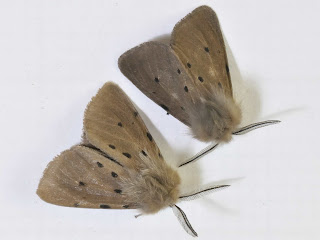The first - and uncontroversial - is Martin Wainwright's item earlier today about pale male Muslin Moths. One of the two males that I found in the traps this morning was noticeable paler than the other, though less pale than the one in Martin's photographs, and nowhere near as pale as others on the web. They were very compliant this morning, and I was able to place them side by side to be photographed. The photograph seems to show less difference between them than I saw: to the naked eye, the black dots on the paler one were much more noticeable than on the dark individual.
 |
| Muslin Moths, Newton Longville 21st April |
 |
| Head-on view of Muslin Moths (paler one on the left) |
 |
Quakers - L and C: Newton Longville 21st April (Tim Arnold)
R: Garsington 17th April (Steve Lockey)
|
You can see that my Quakers were initially showing their antennae. The moth on the right only showed one antenna, and it then stowed even that away when I tried to take a closer photograph: hence its undignified position in the photo below.
 |
| View of possible Powdered Quaker, showing antenna |
After reading the various sources, including Chris Lewis's site to which Martin Harvey referred, I think mine is a Powdered Quaker. It is slightly larger than its cousin; the forewing seems more pointed, the ground colour is paler (though Common Quakers are very variable); there's a fine speckling of black dots; the trailing half of the kidney is darker even if the stigma are large, and it has the line of dark dots beyond it. I'm only a novice and sometimes it feels like the more I read, the less I think I know! I've retained the moth, just in case.
Tim Arnold
Newton Longville, Bucks

Interesting comparison Tim. I think you have a female Common Quaker and a male Powdered Quaker. As for Steve's moth, it's looking to me like a hybrid between the two :) really not sure what it is.
ReplyDeleteThanks, Martin. It was a piece of luck that with such a small number of moths that night, there was both a Common Quaker (albeit a very normal form) and a Powdered Quaker. That gave me the idea of making a side-by-side comparison, and of bringing in Steve's moth.
ReplyDeleteNice comparison shot. Makes me even more certain that Steve's was a Powdered Quaker :)
ReplyDelete